Traduzione generata automaticamente
Mostra originale
Mostra traduzione
Roger Bohnenblust, born August 15, 1929 in Mulhouse and died May 30, 1979 in Friborg, is a Swiss painter, designer and engraver. Roger Bohnenblust was born in Mulhouse in August 1929, in a Protestant family from Haut-Rhin. He is the son of Werner Bohnenblust, electrician fitter originally from St. Gallen, born in 1899, and of Anna, née Neumann, in 1901. Barely three months after the birth of Roger, the family left Alsace for s' settle in Algiers, where the little boy spent part of his childhood. The circumstances of this installation in North Africa are not known to us today. The family only lived there for a few years before moving to Switzerland in 1935, first to Lucerne and Lausanne; five years later, they took up residence in Friborg. Roger's father entered the service of Entreprises Electriques Fribourgeoises as an assembler. His mother, meanwhile, runs a newspaper kiosk very popular with students on Boulevard de Pérolles; highly sensitive to the visual arts, she strongly encourages Roger to embark on the artistic career to which he aspires. After completing his compulsory primary and secondary school years in the Bourg district, he first studied painting and graphic design at the Ecole des Arts et Métiers in Vevey, between 1947 and 1948, then improved his skills in the workshop of Fribourgeois René Dessonnaz, illustrator from the Cantonal Technicum, from 1949 to 1951. In 1951, eager to broaden his horizons, young Roger left for Paris. There he studied drawing at the Louvre School first, then theatrical decoration and poster design in the studio of Paul Colin (poster artist), who also introduced him to the art of lithography. He also made him aware of the work of Toulouse-Lautrec, from which Bohnenblust would draw inspiration to perform certain works. In 1977, he produced a cycle of paintings for the Embassy, a cabaret located in Friborg, representing cancan dancers or a naked young woman coming out of the bath, reminiscent of his Parisian era. Attracted by the profusion of shows offered by the City of Light and which he attends, the Fribourgeois also tries his hand at various projects of sets for operas and plays, costumes, in particular for Agamemnon, Othello or even Prometheus, in the spirit of the cartoons executed by the decorator and scenographer Christian Bérard. If he did not subsequently produce large sets, we owe him those of a certain number of shows, including "Le Baladin du monde occidental" which was given at the Collège Saint-Michel (Friborg) in 1960, sets executed in collaboration with the artist and teacher Jean Dousse. In addition to this stay, he frequently travels to France where one of his maternal uncles resides with his family in the Paris region, in Juvisy-sur-Orge. He exhibited there on several occasions at the "Salon de Juvisy" which takes place in the village hall. Between 1952 and 1954, returned to Switzerland, Roger held various workshops in Friborg, Basel and Lausanne and tried to live as much as possible from his art, mainly thanks to the realization of various advertising projects for Les Weeks musicales internationales de Lucerne or the Fair. Swiss Basel in 1952, in a style reminiscent of Jean Cocteau and Hans Erni. He spent the next two years at the Swiss National Museum (Landesmuseum) in Zurich as a draftsman alongside his deputy director, Professor Emil Vogt, in the field of archeology and applied arts. During this period, Bohnenblust developed the thoroughness and love for detail that would characterize his future work, starting with that devoted to folk costumes. Work on fine art paper Gray wooden frame with glass pane 61 x 50 x 1 cm
Roger Bohnenblust, nato il 15 agosto 1929 a Mulhouse e morto il 30 maggio 1979 a Friborg, è un pittore, designer e incisore svizzero. Roger Bohnenblust è nato a Mulhouse nell'agosto del 1929, in una famiglia protestante dell'Haut-Rhin. È figlio di Werner Bohnenblust, montatore elettricista originario di San Gallo, nato nel 1899, e di Anna, nata Neumann, nel 1901. Appena tre mesi dopo la nascita di Roger, la famiglia lasciò l'Alsazia per stabilirsi ad Algeri, dove il bambino trascorse parte della sua infanzia. Le circostanze di questo insediamento in Nord Africa non ci sono note oggi. La famiglia visse lì solo per qualche anno prima di trasferirsi in Svizzera nel 1935, prima a Lucerna e Losanna; cinque anni dopo, si stabilì a Friborg. Il padre di Roger entra al servizio delle Entreprises Electriques Fribourgeoises come assemblatore. La madre, invece, gestisce un'edicola molto frequentata dagli studenti sul Boulevard de Pérolles; molto sensibile alle arti visive, incoraggia fortemente Roger a intraprendere la carriera artistica a cui aspira. Dopo aver completato gli anni della scuola primaria e secondaria obbligatoria nel distretto di Bourg, studia prima pittura e grafica all'Ecole des Arts et Métiers di Vevey, tra il 1947 e il 1948, poi si perfeziona nell'atelier del friborghese René Dessonnaz, illustratore del Technicum cantonale, dal 1949 al 1951. Nel 1951, desideroso di ampliare i suoi orizzonti, il giovane Roger parte per Parigi. Qui studia prima disegno alla Scuola del Louvre, poi decorazione teatrale e cartellonistica nello studio di Paul Colin (cartellonista), che lo introduce anche all'arte della litografia. Questi gli fa conoscere anche l'opera di Toulouse-Lautrec, da cui Bohnenblust trarrà ispirazione per realizzare alcune opere. Nel 1977 realizzò un ciclo di dipinti per l'Embassy, un cabaret situato a Friborg, che rappresentavano ballerine di cancan o una giovane donna nuda che usciva dal bagno, ricordando il suo periodo parigino. Attratto dalla profusione di spettacoli che la Città della Luce offre e a cui assiste, il friborghese si cimenta anche in vari progetti di scenografie per opere liriche e teatrali, costumi, in particolare per Agamennone, Otello o anche Prometeo, nello spirito dei cartoni eseguiti dal decoratore e scenografo Christian Bérard. Se in seguito non realizzò grandi scenografie, gli dobbiamo quelle di un certo numero di spettacoli, tra cui "Le Baladin du monde occidental" che si tenne al Collège Saint-Michel (Friburgo) nel 1960, scenografie eseguite in collaborazione con l'artista e insegnante Jean Dousse. Oltre a questo soggiorno, si reca spesso in Francia, dove uno dei suoi zii materni risiede con la famiglia nella regione di Parigi, a Juvisy-sur-Orge. Lì espone in diverse occasioni al "Salon de Juvisy" che si svolge nella sala del villaggio. Tra il 1952 e il 1954, tornato in Svizzera, Roger tiene vari atelier a Friborg, Basilea e Losanna e cerca di vivere il più possibile della sua arte, soprattutto grazie alla realizzazione di vari progetti pubblicitari per Les Weeks musicales internationales de Lucerne o per la Fiera. Basilea svizzera nel 1952, in uno stile che ricorda Jean Cocteau e Hans Erni. I due anni successivi li trascorre al Museo Nazionale Svizzero (Landesmuseum) di Zurigo come disegnatore al fianco del suo vicedirettore, il professor Emil Vogt, nel campo dell'archeologia e delle arti applicate. In questo periodo Bohnenblust sviluppa la scrupolosità e l'amore per il dettaglio che caratterizzeranno la sua opera futura, a partire da quella dedicata ai costumi popolari. Opera su carta patinata Cornice di legno grigio con lastra di vetro 61 x 50 x 1 cm

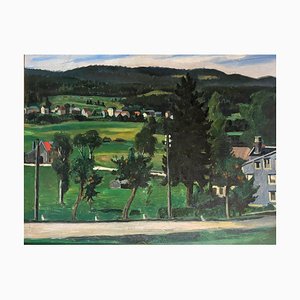

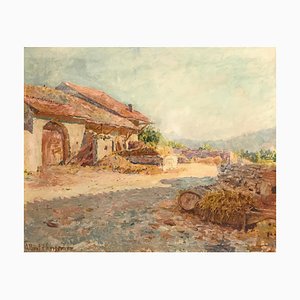
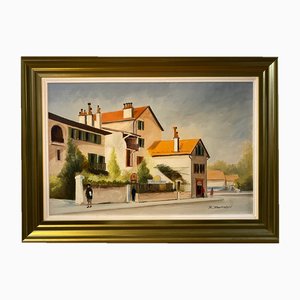
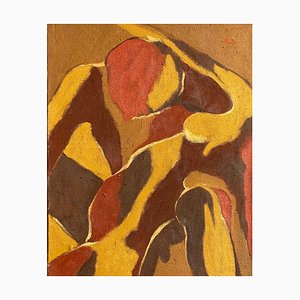
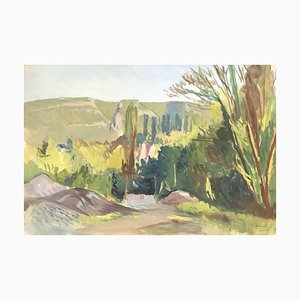



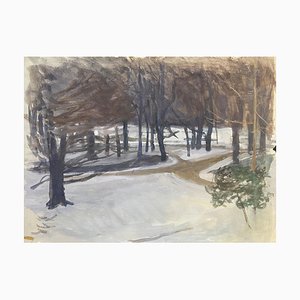
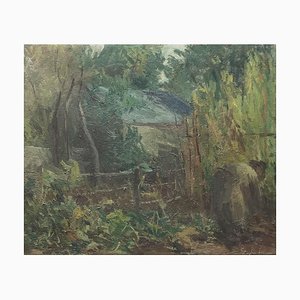

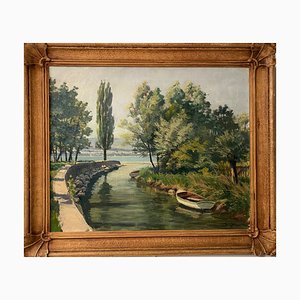
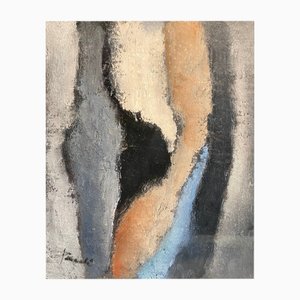

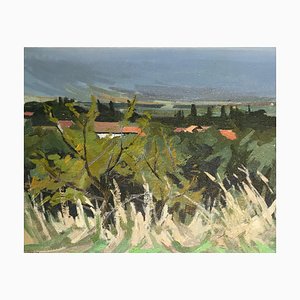



Contattaci
Fai un'offerta
Abbiamo notato che sei nuovo su Pamono!
Accetta i Termini e condizioni e l'Informativa sulla privacy
Contattaci
Fai un'offerta
Ci siamo quasi!
Per seguire la conversazione sulla piattaforma, si prega di completare la registrazione. Per procedere con la tua offerta sulla piattaforma, ti preghiamo di completare la registrazione.Successo
Grazie per la vostra richiesta, qualcuno del nostro team vi contatterà a breve.
Se sei un professionista del design, fai domanda qui per i vantaggi del Programma Commerciale di Pamono